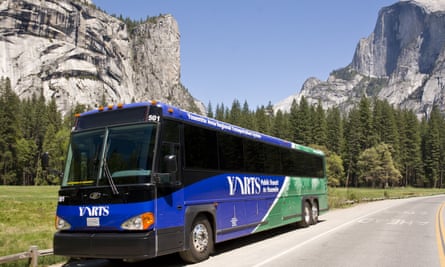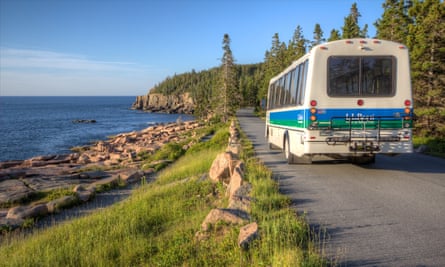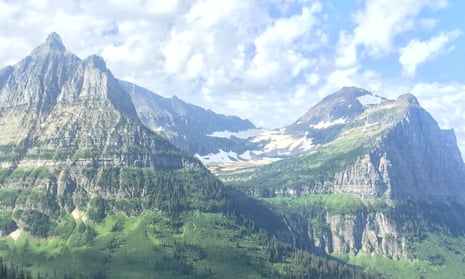If you’ve ever visited an iconic national park like Yellowstone, Yosemite or Glacier, your first glimpses of arresting, postcard-perfect vistas were probably framed by a car window. That’s how I first glimpsed Yosemite’s Half Dome. After driving through the tunnels on Big Oak Flat Road, the road curved and the valley came into view. Angels sang. I was so overwhelmed by that monolith’s grandeur and beauty that I had to pull over onto the shoulder and have a good cry.
Years later, I stuffed my backpack with supplies and headed out my front door, Yosemite bound once again. I walked 10 minutes to the nearest San Francisco Bay Area Rapid Transit (Bart) station, which I rode east, to the Richmond station, and transferred to Amtrak. I used the train’s free Wi-Fi to get some work done during the scenic two-hour and 40-minute ride to Merced, California, where I waited a half hour for a Yosemite Area Regional Transportation System (Yarts) bus up to Yosemite, another two-hour trip.
In total, my fares were double what I’d have paid in gas, but bus riders are exempt from the park’s entrance fee ($20 then, $30 now). The trip took more than an hour longer than driving would have, though slogging through Bay Area traffic could have evened that scale. One less car in the crowded, summer-packed Yosemite Valley that day made an imperceptible difference to the park’s clogged roads and parking lots. But once I was inside the park, the free park shuttles and my own two feet took me everywhere I wanted to go. I experienced zero road rage and could have wept over Half Dome to my heart’s content without worrying about swerving off the road.
One hundred years ago, former US president Woodrow Wilson signed the legislation that created the National Park Service (NPS) to manage 35 parks and monuments. Since then, the number of national parks has swelled along with crowds. Back in 1916, a few hundred thousand people would visit those parks each year. But by the late 1990s, visitation to the hundreds of landmarks within the park system rose to around 280 million, and by last year it reached 307 million. The popularity of the country’s national parks has risen along with the number of highways and privately-owned vehicles.
Between the 1965 and 1985, visitation to the NPS grew 122%, and the crown jewels of our collectively-owned landscape started to suffer from congestion, which degraded air quality – not to mention the quality of the experience.
Some parks, including Denali National Park in Alaska and Zion National Park in Utah, started to restrict vehicular access, requiring visitors to take shuttles through the park, due to safety issues or congestion problems, or to reduce impacts to wildlife. But many parks responded to increased traffic by building bigger parking lots. That has a smaller price tag, at least in the short term, than creating systems for alternative transportation, which national parks have struggled to pay for.
The benefits of limiting cars to minimize environmental impact aren’t straightforward, however, says Francesco Orsi, an assistant professor of geography at Kansas State University and the editor of Sustainable Transportation in Natural and Protected Areas. Cars may be a big source of air pollution and carbon emissions, but they also limit the number of people wearing out trails and trampling through areas with sensitive habitats.
“In Rocky Mountain National Park, they introduced buses and realized they were bringing in more people,” Orsi says. “With buses, there was more capacity and (that creates) more demand on the trail system. So they had to find a balance between buses and cars.”
During the next 100 years, Orsi says the biggest impact our cars will make to national parks won’t come from the tailpipes. “In the future [thanks to electrification], cars won’t emit carbon. The big issue is that cars occupy space.” That means building parking lots on land that would otherwise remain wild and leave behind visual scars. Orsi has seen this in his native Italy. “In the Dolomites, when you climb a mountain, you look down and see an ocean of cars.”
In 2010, the Federal Transit Administration launched Transit in Parks, a granting program that directed $80m to transit programs for the NPS. This seeded some promising projects, but funding was axed in the 2012 federal transportation bill. This, and its own addled budget, led the NPS to rely more on state and municipal authorities, as well as private businesses, to develop and support public transit projects.
The NPS has had mixed success trying to ease congestion while still making public lands accessible. Here, we profile three of the service’s most promising programs.

Golden State success story
Yosemite Area Regional Transportation System (Yarts) is a government agency funded mostly by the counties it serves and by Yosemite National Park – in fact, the park provides around 36% of Yarts’ operating budget. Yarts, which passed its one-millionth rider mark in 2014, also has contracts with Amtrak and Greyhound, which many riders use to connect to the buses. Revenue from fares accounts for 18% of its budget. (A round trip between Merced and Yosemite is $25.)
Businesses in the gateway communities near Yosemite also benefit from Yarts, says its manager Dick Whittington. “We have an excellent relationship with hotels. And the RV parks on Highway 120 are big Yarts promoters, because guests come in, hook up their RVs [to water, power and sewer lines] and then don’t want to unhook them to drive up to Yosemite, so they take the bus. We also have folks who come on Amtrak, ride the bus to their hotel and then into the park the next day.”
Last year, Yarts launched a new summer route to Fresno, California’s fifth largest city. With its international airport, the Fresno link opens up a direct transit route for visitors flying into the state. Even though it was a new service, Yarts picked up almost 700 people at the Fresno airport last summer.
Lessons from Yellowstone
Driving and traffic congestion weren’t always part of the national park experience, says Jan Brown, the former executive director of the Yellowstone Business Partnership (YBP), a now dissolved nonprofit that worked to introduce the principles of sustainable business practices to the communities around Yellowstone National Park.
When Yellowstone was founded in 1872, public transit – provided by a horseman and a coach – was the only way to see that park. Later, guests arrived via rail. But once cars took over the roads, they came to define access to public lands.
In 2011, the YBP, along with seven different public transportation providers in Idaho, Montana and Wyoming, launched a co-operative, dubbed Linx, to provide bus services into the park from surrounding communities. The project, launched with a $500,000 federal grant, envisioned shuttles every 20 minutes linking regional airports in Idaho Falls, Salt Lake, Bozeman and Billings to Yellowstone.
“The Transit in Parks programs were controlled by the park service and needed their approval, but our idea was to not start a new public transit system – that was very important,” says Brown. “What we wanted to do was support [transportation] businesses all around the park.”
Linx provided rides from mid-June through September for three years. Single day tickets were $20, or $80 for a five-day pass. In 2012, Linx ran a pilot program, sponsored by New Belgium Brewing, in which bike racks were mounted on select buses. Many Linx users used the service as a shuttle, allowing them to undertake a long day hike or multi-day backpack trip and then return via bus.
Steeped in debt and unable to find financial support, Linx, as well as the YBP, went under in 2014.
Brown believes Linx may have been ahead of its time. She says mobile phone apps, which back in 2011 were more expensive and difficult to deploy, would have made scheduling and advertising the service far simpler. In the end, most Linx riders were park employees, not the tourists that the providers were targeting.
“We had urged Yellowstone National Park to support our mobility plan,” says Arthur Kull, who was president of Linx. “[But former] Yellowstone Superintendent Dan Wenk refused to allocate any funds to our project.”

Maine’s gold standard
For nearly two decades, the Island Explorer bus service in Maine’s Acadia National Park has provided some relief to the park’s congestion problems while also linking tourists to hotels, restaurants and other businesses outside the park.
Downeast Transportation, a private nonprofit, operates the Island Explorer. During its 1998 pilot year, the Island Explorer served park campgrounds and charged $2 fares. The next year, says general manager Paul Murphy, “We asked the Friends of Acadia [a park advocacy group] to do an experiment. We asked: what would happen if we removed fare?” Padded with a $3,500 grant from the group, the bus trips became free and ridership grew by 600%.
At the onset, the service aimed to transport 1,000 passengers per day. Now, with a far wider route map and more busses, the Island Explorer regularly moves 5,000-6,000 people each day during the park’s peak season. That number has reached 8,000 on busy days. By providing an alternative to driving, Downeast Transportation estimates that the service has replaced 2.3m vehicle trips and reduced 21,504 tons of greenhouse gas emissions.
Acadia uses half of each park visitor’s entry free to help the Island Explorer – the park provides more than 40% of the bus system’s funding. The Federal Transit Authority’s rural transit funds and the Maine Department of Transportation cover the second largest portion, followed by Maine-based outdoor gear seller LL Bean, which has sponsored the bus system with $4m over the years. Businesses outside the park that host bus stops also contribute. Plus, donation boxes inside the buses generate $50,000 each year.
Tourists arriving via the airport at Bar Harbor, a quaint town just outside of Acadia, can jump on the Island Explorer right from the terminal, though the vast majority of out-of-towners drive to Acadia and then switch to the bus service, Murphy says.
Tom Crikelair, a transportation planning consultant who helped develop the Island Explorer program, says there is no silver bullet to developing a sustainable transportation system.
“Just because it works here, you can’t necessarily do the same thing elsewhere. It all depends on convenience: if you want someone to get out of their car, you’ve got to give them something better than their car,” Crikelair says.

Comments (…)
Sign in or create your Guardian account to join the discussion